
More than a decade ago, the late Joan Petersilia, Ph.D. said in a Q&A with the Pew Center on the States that “we need to invest heavily in helping offenders who are not yet steeped in criminal behavior and wish to chart a different path.” She also said these investments in community corrections programs should be based on science, not intuition or guesswork. At the time of the interview, 2007, research on what worked in corrections was limited.
Since that interview (“What Works in Community Corrections”), many of the things she discussed have moved forward. “What Works”is now a term used nationally by correctional agencies in reference to researched principles and practices common to effective public safety and offender programming. What Works research has also identified the offender attributes, criminogenic risks and needs, that successful correctional programs must target.
The mission of a What Works system states that public safety and offender change are accomplished by risk control and risk reduction through an integrated system of sanctions and interventions. A What Works environment means that everyone who has anything to do directly or indirectly with an offender, from entry into the system to completion, is focused on assisting that person to be successful and is consistent on how they do that.
GEO Reentry has invested significantly in core elements of a good community corrections program using What Works principles for its residential reentry programs, non-residential day reporting programs, and in-custody training programs. These core elements include:
- Using an objective risk and needs assessment so individual behavior change plans can be crafted;
- Maintaining program fidelity and quality by using scoring methods such as the University of Cincinnati’s Correctional Program Checklist (CPC) or Criminal Thinking Scales developed by Texas Christian University;
- Raising staff qualifications and delivering rigorous training;
- Using a tested curriculum or program model, such as applying Thinking for a Change or Moral Reconation Therapy, which deliver cognitive behavioral treatment;
- Using social learning methods.
All of these practices have been shown to reduce risk and recidivism by getting the right offender in the right program. Effective treatment based on What Works addresses:
- Criminogenic risk
- Criminogenic need
- Responsivity
- Relapse prevention strategies
The Backbone of What Works involves social learning and cognitive behavioral treatment. The primary tenet of social learning theory is that people can learn new behaviors, attitudes and feelings by observing other people and events followed by individual practice of appropriate thoughts and behaviors. Cognitive programs are based on the theory that how people think determines how they act and that all people are capable of changing their thought processes and thereby, their behaviors.
While GEO Reentry’s model will continue to adapt and evolve, the essential components of its system will include lead models competent in data-driven service approaches; evidence-based practice; the availability of a full continuum of services from assessment through aftercare/discharge; community collaboration and partnership; and balanced decision-making.
For more information about GEO Reentry’s What Works programs, contact one our regional directors. Or, download our free white paper, “What Works in Corrections to Reduce Recidivism.”
